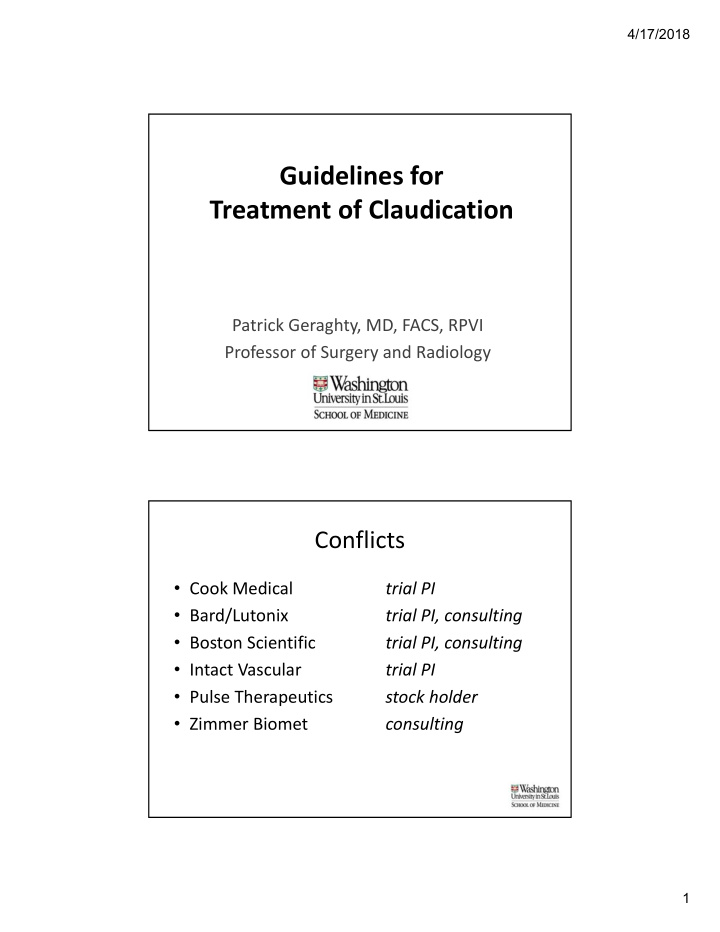



4/17/2018 Guidelines for Treatment of Claudication Patrick Geraghty, MD, FACS, RPVI Professor of Surgery and Radiology Conflicts • Cook Medical trial PI • Bard/Lutonix trial PI, consulting • Boston Scientific trial PI, consulting • Intact Vascular trial PI • Pulse Therapeutics stock holder • Zimmer Biomet consulting 1
4/17/2018 2015 SVS Guidelines Document PAD: Patterns of Presentation • Asymptomatic PAD • Claudication • Chronic Limb‐Threatening Ischemia (CLTI) 2
4/17/2018 Asymptomatic PAD • In general, no intervention is required • Value of ABI screening for asymptomatic patients is contentious – USPSTF and SVS do not support; AHA supports – Maximizing CV risk stratification, or trolling for cases? • ABI is a marker for systemic CV disease – Deaths primarily result from MI and CVA, not limb loss – “Golden window” for modifying risk factors Risk Factors for PAD 3
4/17/2018 Natural History of Claudication Confirming the Diagnosis • Careful history and physical examination – Induced by exercise, relieved by rest – Reproducible; not positional; not present at rest – Consistent with pulse exam (and waveforms) – Rule out diseases that may mimic PAD • Spinal stenosis • Venous claudication • Ankle‐Brachial Index 4
4/17/2018 Ankle‐Brachial Index • 0.9‐1.3 Normal Range • 0.5‐0.8 Claudication • < 0.4 CLTI and • Non‐compressible/Calcified/>1.4 – Waveform Analysis/Digit Pressures Confirming the Diagnosis, Part 2 • Symptoms are consistent with claudication, but the resting ABI value is normal • Exercise ABI (treadmill study) – Postexercise ABI < 0.9 – Absolute pressure drop of > 30 mm Hg – Drop of 20% of baseline ABI – Delayed recovery (> 3 minutes) of resting ABI 5
4/17/2018 When to Image? • Lesion localization and characterization • Arterial duplex, CTA, MRA, angiography • Imaging studies usually do not change the plan for risk factor modification, ergo… • Imaging studies are best reserved for those patients for whom revascularization is being considered First Principles of IC Management • ALL patients should receive maximal risk factor modification – Reduction in CV morbidity and mortality – Better results with subsequent intervention • SOME patients should receive intervention – Variable QOL benefit – Employment and critical ADLs – Symptom progression 6
4/17/2018 Smoking Cessation • Continued smoking results in: – Increased amputation rates – Increased rates of death, stroke, and MI – 2x‐3x increase in the failure rate of lower extremity bypass grafts • “Set the hook” at the first clinic visit Dyslipidemia Management • Mounting evidence suggests that all symptomatic PAD patients should receive high‐intensity statin therapy • Additional benefit for periprocedural outcomes with statin therapy 7
4/17/2018 Value of High‐Intensity Statins in PAD - Arya et al , Circulation 2018; 137:1435-1446 . High‐Intensity Statins in PAD: Mortality - Arya et al , Circulation 2018; 137:1435-1446 . 8
4/17/2018 High‐Intensity Statins in PAD: Amputation - Arya et al , Circulation 2018; 137:1435-1446 . Diabetes Management • Amputation rates in DM + PAD are 5x‐10x higher than in nondiabetic PAD population – Sensory neuropathy – Increased susceptibility to infection • Need further studies to demonstrate reduction in adverse CV events via optimal DM control 9
4/17/2018 Other Risk Factors • Hypertension management – Ramipril • 25% reduction in cardiac events in HOPE study • Thrombophilia management – ASA – ASA + clopidogrel • CAPRIE study showed additional 24% reduction in CV events Symptom Management • Cilostazol – rule out CHF – surface echocardiogram if needed – 10% or more are intolerant – does NOT replace exercise therapy 10
4/17/2018 Symptom Management • Structured exercise therapy – 50‐200% improvement in walking ability – finally compensation although rates are highly variable among payers – 6 month program produces better results than shorter periods of training • Patient‐initiated exercise therapy – goal of 30 minutes per session, 4x per week – climate controlled, space to stand/sit Revascularization for IC • Cut the losers from the herd: – those who are minimally symptomatic from IC – those whose activity is otherwise restricted and will see little benefit from revascularization • COPD, spinal stenosis, arthritis – those who lack adequate GSV for bailout bypass • 3 mm conduit extending beyond your intervention 11
4/17/2018 Revascularization for IC • Cut the losers from the herd: – those who are at prohibitive cardiac risk • angina, severe valvular disease – those who are very young or very old • maintain focus on risk factors, surveillance – those who have small diameter arteries • SFA 4 mm or less Revascularization for IC • Critically assess the arterial anatomy – Personal preference: CTA – Delineates aneurysms – Provides a clear picture of calcium burden – Can usually assess flow patterns to trifurcation despite Ca++ • Stage your options – visualize the sequential endo/OR options that will yield the least risk and the best long‐term patency • Endovascular approach first if the expected patency is > 50% at 2 years 12
4/17/2018 Revascularization for IC • Don’t skimp on surgical approaches! • Concomitant CFA disease usually best treated by endarterectomy & paching with bypass or endovascular inflow (hybrid procedure) Revascularization for IC • Endo Patency: Aortoiliac > SFA > Popliteal • Endovascular: avoid heavy CFA disease, flush occlusions, small diameter arteries, extension through trifurcation, jailing of patent vessels (PFA!) • “No Metal Left Behind” vs “Patency Is King” 13
4/17/2018 How Do I Manage Claudication? • Initial visit – address risk factors – scare them off tobacco and link delayed intervention to tobacco abstinence – trial of cilostazol and exercise therapy • Reevaluate at 3 months – intervene if disabling and anatomy is favorable – CTA of aorta/iliacs/lower extremities – GSV mapping How Do I Manage Claudication? • Performing leg interventions for 20 years • The proportion of my lower extremity cases has steadily been shifting towards CLTI • The CLTI epidemic will keep all of us busy; be selective and goal‐oriented with your claudication interventions 14
4/17/2018 QUESTIONS? 15
Recommend
More recommend